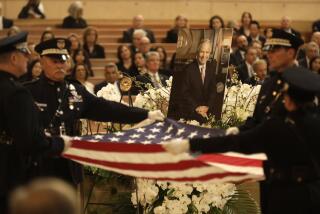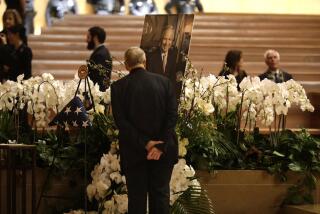LeGrand Lewis Jordan, 100; CHP Officer, Motorcycle Designer
- Share via
He acquired his first motorcycle in 1917. It didn’t have a motor, so he built one.
He joined the 70-man Los Angeles County Motor Patrol in 1930, ticketing anybody who drove faster than 45 mph--a speed few vehicles could even reach.
Two years later, when Los Angeles became the last county to dissolve its own force and accept the California Highway Patrol, he joined.
LeGrand Lewis Jordan, who patrolled the pre-freeway San Gabriel Valley for 26 years, cycled across the country numerous times just for fun and even created his own prototype motorcycle, has died. He was 100.
Jordan died Friday of heart failure after finishing dinner in his Malibu home, said his grandson, Randy Azarian.
Born in LaGrande, Ore., when William McKinley was president, Jordan moved 15 times in 15 years with his railroading father before the family settled in Los Angeles. Intrigued since early childhood by mechanics and how things worked, the boy developed his engineering talents during his student days at Polytechnic High School.
From that initially motorless motorcycle he got at 16, Jordan rode his way through the classics--a Monarch, a Cleveland, an Indian Scout--on the way to his favorite: a BMW.
Ultimately, he built his own: the Jordan, a shaft-driven, electric-starting, square-four-cylinder design that was 300 pounds lighter than the Harley-Davidsons he was riding for the CHP.
Jordan and his younger brother, Eugene, with whom he owned a car repair garage on South Figueroa Street, presented the prototype to the Army in 1937. Great idea, officials agreed, but they left it to Jordan to find his own funding to build more. In the Depression era, he was unable to do that.
So the Jordan Twin Crank Four prototype sits in pristine and unique glory, one of 20 classics in the Otis Chandler Motorcycle Gallery of the Petersen Automotive Museum in Los Angeles.
If its inventor never got rich, he did enjoy a long and interesting life as a pioneering motorcycle officer.
And in the hundreds of thousands of miles he rode for work and play, he had only one accident. It cost him two stitches in his scalp.
“I was chasing a speeder at 45 miles an hour through a business zone when a woman drove through a boulevard stop in front of me,” he told The Times when the mishap occurred in 1947. “But when you chase speeders, you have to do things--because it’s your job to do them--that you wouldn’t do as a sensible civilian driver.”
A stickler for safety, Jordan had a simple formula for safe motorcycle riding: “All you have to do is to keep in mind every single second while you are driving that you can’t trust anybody else’s driving.”
His service to the CHP ended when surgery for a slipped disc forced him to take early retirement in 1956.
“Those Harley-Davidson motorbikes we rode were the meanest monopoly on the face of the Earth; they had no springs, no shock absorbers,” he later told his grandson. “They were rigid mount until 1949, and they just beat your kidneys and back to death.”
To know Jordan was to ride behind him on the bike. He took his mother for a spin on her 75th birthday. He took older daughter Bette or younger daughter Gloria along on numerous cross-country jaunts, including one to the New York World’s Fair in 1939.
That fair-bound journey rated a story in the New York Times, which asked why he didn’t add a sidecar for his teenager’s greater comfort. “I wouldn’t have a sidecar on a motorcycle,” he was quoted. “When you have a sidecar you don’t have a motorcycle. You just have a contraption.”
During Jordan’s long retirement, his grandson said, he traveled extensively and continued repairing and rebuilding “every imaginable mechanical apparatus.” Among the perfectly restored treasures he left behind are a 1931 Ford Model A and a 1958 Volkswagen Beetle.
Jordan also helped promote the CHP magazine and helped found the Asphalt Arabs, an association of retired CHP officers.
Jordan’s wife of 67 years, Margaret, and their daughter, Bette, predeceased him. He is survived by a daughter, Gloria Azarian; brother, Eugene; sister, Jovita; and five grandchildren and seven great-grandchildren.
Graveside services will be private.






